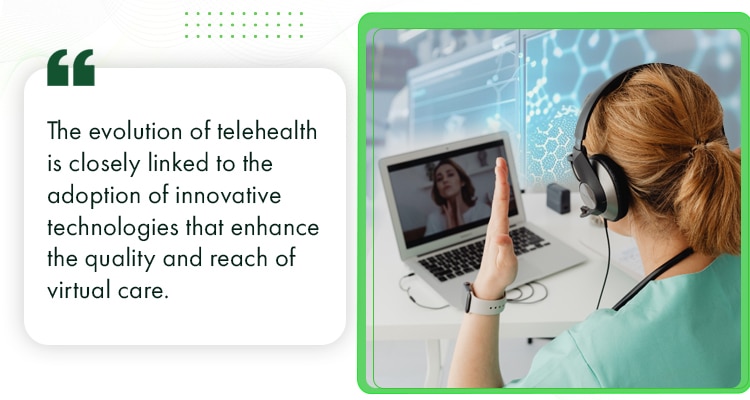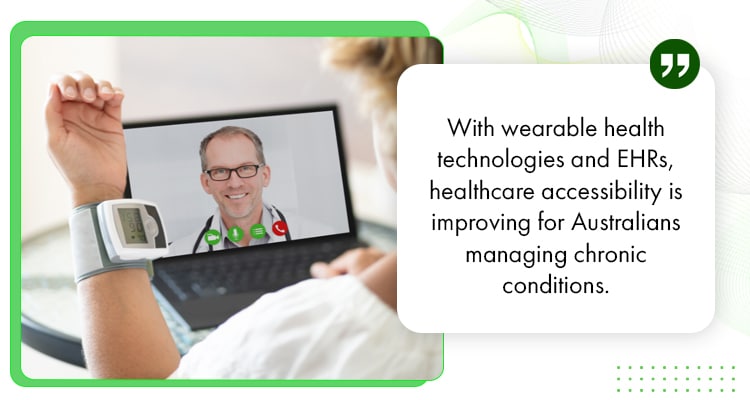Imagine a future where seeing a doctor doesn’t mean sitting in a waiting room for hours, but instead, getting to your appointment in a few clicks.
Well, that future is already here!
Telehealth is no longer just a backup option—it’s redefining the way people access medical care.
From AI-powered imaging in South Australian hospitals to real-time remote patient monitoring using wearable technology, digital healthcare is advancing at an unprecedented pace.
Even the Olivia Newton-John Cancer Research Institute is harnessing AI to revolutionise cancer treatment. Meanwhile, virtual consultations, electronic health records, and digital prescriptions are making it easier than ever to receive quality healthcare without setting foot in a clinic.
But with innovation comes new challenges. How will businesses and healthcare providers adapt to this digital-first approach? What role will a customer support representative and technical support agent play in making telehealth seamless?
Keep reading to discover how telehealth is reshaping Australia’s medical industry—and what you need to do to stay ahead in this rapidly evolving landscape.
The Growth of Telehealth in Australia
In recent years, Australia has witnessed a significant transformation in its healthcare landscape, with telehealth emerging as a mainstream service.
This shift has been driven by technological advancements and the need for more accessible healthcare solutions.
How Telemedicine Became a Mainstream Service
The integration of telemedicine into Australia’s healthcare system has been propelled by several factors:
- Technological Advancements: The widespread adoption of digital health technologies, including video consultations and electronic health records, has facilitated seamless remote healthcare delivery.
- Policy Support: Government initiatives, such as the expansion of the Medicare Benefits Schedule (MBS) to cover telehealth services, have made virtual care more accessible to patients nationwide.
Key Policy Updates and Healthcare Regulations
Recent policy developments have further solidified telehealth’s role in Australia’s healthcare system:
- MBS Expansion: The inclusion of telehealth consultations in the MBS so patients can receive rebates for virtual visits.
- Privacy Regulations: The implementation of stringent data protection laws to safeguard patient information during online medical services.
- Licensing for Practitioners: The establishment of guidelines permitting nurse practitioners and allied health professionals to provide telehealth services enhances healthcare accessibility.
Cutting-Edge Technologies Transforming Telehealth
The evolution of telehealth is closely linked to the adoption of innovative technologies that enhance the quality and reach of virtual care.
The Role of Artificial Intelligence in Digital Medicine
Artificial Intelligence (AI) has become integral to modern healthcare, offering numerous benefits:
- Diagnostic Accuracy: AI algorithms assist in interpreting medical images that lead to more precise diagnoses.
- Predictive Analytics: AI analyses patient data to forecast health trends and potential risks.
- Personalised Treatment: AI tailors medical interventions based on individual patient profiles.
5G and Internet Infrastructure Enhancements

The deployment of 5G networks has revolutionised telehealth by providing:
- Low Latency: Guarantees real-time interactions during a video consultation.
- High Bandwidth: Supports the transmission of high-definition medical imaging.
- Reliable Connectivity: Improves access to telehealth services in remote and rural areas.
Integrating Electronic Health Records for Better Care
The seamless integration of Electronic Health Records (EHRs) into telehealth platforms has:
- Enhanced Care Coordination: Allows healthcare providers to access comprehensive patient histories during virtual visits.
- Improved Decision-Making: Provides clinicians with real-time data, facilitating informed treatment plans.
As telehealth continues to evolve, these technological advancements play a pivotal role in shaping the future of virtual care in Australia.
How Telehealth Benefits Australians
With health technologies advancing rapidly, telehealth has become a game-changer for patients and providers alike.
From video consultations to digital prescriptions, virtual healthcare is expanding accessibility, reducing costs, and improving patient outcomes.
As the Australian healthcare system embraces this shift, customer support representatives, technical support agents, and remote support specialists significantly facilitate seamless virtual care.
Expanding Access to Quality Healthcare
Telehealth services bridge the gap between urban medical hubs and rural communities, making it possible for allied health professionals to provide remote patient care.
Through video and phone consultations, Australians can receive expert medical advice without the need for long-distance travel.
Lowering Costs for Patients and Healthcare Providers
Reducing healthcare expenses is a top priority for both patients and providers, and telehealth is proving to be a cost-effective solution due to:
- Reduced travel expenses. Patients in rural and remote areas no longer need to travel long distances for specialist telehealth services.
- Lower operational costs. Healthcare providers save on clinic space, staffing, and administrative expenses by incorporating online doctor appointments.
- Bulk-billed services under Medicare. The MBS supports telehealth consultations, making healthcare more affordable.
- Fewer hospital admissions. Remote monitoring helps manage chronic diseases, reducing the need for frequent hospital visits.
Remote Monitoring and Chronic Disease Care
With wearable health technologies and EHRs, healthcare accessibility is improving for Australians managing chronic conditions.

Remote patient care allows doctors to track vitals, adjust treatment plans, and provide proactive care, so patients receive continuous support without making frequent in-person visits.
Barriers and Challenges Facing Telehealth Adoption
While telehealth has transformed healthcare accessibility, widespread adoption still faces several challenges.
From technology gaps to privacy concerns, providers and patients must explore these issues to unlock the full potential of online medical services.
Overcoming The Digital Divide and Accessibility Issues
Addressing the following challenges is important to making online medical services truly inclusive:
- Limited internet access in rural areas. Poor connectivity restricts video consultation quality, impacting rural healthcare access.
- Technological literacy. Some elderly patients and disadvantaged communities struggle to use online doctor appointments effectively.
- Device availability. Not all patients have access to smartphones, computers, or compatible health technologies for telehealth services.
Addressing Privacy and Cybersecurity Concerns
As telehealth adoption grows, protecting patient data and online medical services from cyber threats is vital for maintaining trust and compliance:
- Secure patient data storage. EHRs must comply with strict privacy laws to prevent breaches.
- End-to-end encryption. Video consultations and live chat support should incorporate cybersecurity measures to protect patient confidentiality.
- Educating patients and providers. Both healthcare professionals and patients need training on cybersecurity best practices to mitigate risks.
Adapting to New Healthcare Models
The continuous growth of telehealth relies on healthcare providers who must:
- Integrate telehealth into traditional healthcare. Many clinics and hospitals still rely on in-person consultations and must adapt to hybrid models.
- Train healthcare professionals. Nurse practitioners working on telehealth services require training in remote patient care and digital technologies.
- Establish clear telehealth guidelines. Government policies and MBS expansions must keep pace with digital advancements.
The Future of Telehealth in Australia Beyond 2025
The next wave of digital telehealth innovation will focus on scalability, accessibility, and integration with in-person care.
With AI-driven diagnostics, remote patient monitoring, and enhanced connectivity, health technologies will further streamline healthcare delivery.
Businesses, healthcare providers, and support professionals will play an important role in establishing seamless access to virtual healthcare services.
Virtual Hospitals and Home-Based Care
With advancements in remote patient care, the concept of virtual hospitals is fast becoming a reality.
Patients with chronic conditions or post-surgical recovery needs will be monitored at home using wearable health technologies, reducing hospital overcrowding and improving healthcare accessibility.
Blending Virtual and In-Person Medical Services
To provide comprehensive care, telehealth should have these in its trajectory:
- Hybrid healthcare models. Combining video consultations with in-person check-ups to provide a more comprehensive care experience.
- Allied health professionals and nurse practitioners telehealth integration. Expanding remote services to include physiotherapy, mental health support, and specialist consultations.
- Live chat support for patient inquiries. Enhancing patient engagement with real-time access to health professionals and digital support teams.
- On-demand remote consultations. Providing faster access to specialist telehealth services while maintaining a patient-centered approach.
Advancements in Medical Technology
Here are the following approaches that can further revolutionise telehealth:
- AI-powered diagnostics. Artificial intelligence will assist doctors in analysing medical scans and patient data, improving diagnostic accuracy.
- 5G-enhanced telehealth. Faster and more reliable connectivity will improve video consultation quality, particularly for rural healthcare access.
- Expanded electronic health records. Seamless data sharing across healthcare providers will enhance patient care coordination.
- Digital prescriptions and remote medication management. Patients will receive digital prescriptions and access automated reminders for medication adherence.
Frequently Asked Questions (FAQ)
Here are answers to common questions about telehealth.
What is covered by Medicare for telehealth in 2025?
MBS covers bulk-billed video consultation, phone consultation, and specialist telehealth services, making sure that patients have continued access to virtual care under specific eligibility requirements.
Which medical services are available via telehealth?
Patients can access a wide range of telehealth services, including GP appointments, mental health therapy, specialist consultations, allied health support, and remote monitoring for chronic conditions.
How secure is patient data in virtual healthcare?
Virtual healthcare platforms use advanced encryption, multi-factor authentication, and strict compliance with Australian privacy laws to protect data from cyber threats.
Final Thoughts
The rise of telehealth is a permanent shift in healthcare delivery. As digital innovations continue to reshape the industry, everyone in the healthcare sector must stay ahead by adopting new technologies and adapting to the changing needs of patients.

Are you ready for the future of telehealth?
Whether you’re a healthcare provider, a customer support representative, or a business leader, now is the time to embrace virtual healthcare solutions and contribute to a more accessible, efficient, and patient-centric future!
- Want FREE AI Prompts for Different Areas of Your Business? Check out these 100 AI prompts.
- Curious About How to SAVE and Maximize on Taxes? Learn more here.
- If you’re ready to experience the full advantages of working with a top global team, check out our 1,000 fully vetted and highly talented staff here.
Darren Aragon is a multifaceted writer with a background in Information Technology, beginning his career in research at Pen Qatar and transitioning through customer service to a significant role at Absolute Service, Inc. His journey into freelance writing in 2021 has seen him excel across various niches, showcasing his adaptability and deep understanding of audience engagement.




















